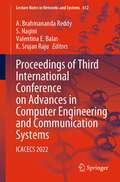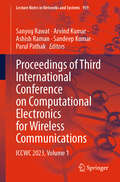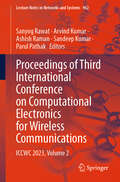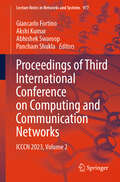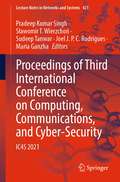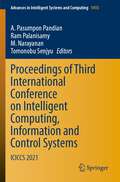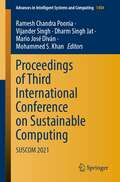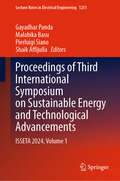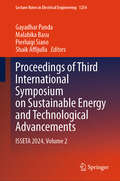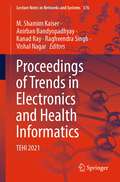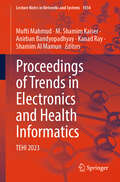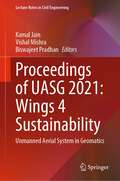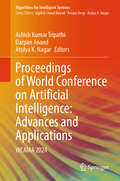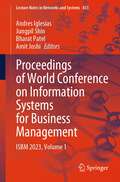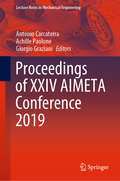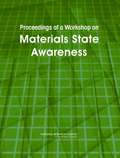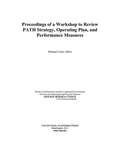- Table View
- List View
Proceedings of Third International Conference on Advances in Computer Engineering and Communication Systems: ICACECS 2022 (Lecture Notes in Networks and Systems #612)
by K. Srujan Raju Valentina E. Balas A. Brahmananda Reddy S. NaginiThis book includes original, peer-reviewed research articles from International Conference on Advances in Computer Engineering and Communication Systems (ICACECS 2022), held in VNR Vignana Jyoythi Institute of Engineering and Technology (VNR VJIET), Hyderabad, Telangana, India, during August 11–12, 2022. The book focuses on “Smart Innovations in Mezzanine Technologies, Data Analytics, Networks and Communication Systems” enlargements and reviews on the advanced topics in artificial intelligence, machine learning, data mining and big data computing, knowledge engineering, semantic Web, cloud computing, Internet of Things, cybersecurity, communication systems, and distributed computing and smart systems.
Proceedings of Third International Conference on Communication, Computing and Electronics Systems: ICCCES 2021 (Lecture Notes in Electrical Engineering #844)
by Ke-Lin Du João Manuel R. S. Tavares V. BindhuThis book includes high quality research papers presented at the International Conference on Communication, Computing and Electronics Systems 2021, held at the PPG Institute of Technology, Coimbatore, India, on 28-29 October 2021. The volume focuses mainly on the research trends in cloud computing, mobile computing, artificial intelligence and advanced electronics systems. The topics covered are automation, VLSI, embedded systems, optical communication, RF communication, microwave engineering, artificial intelligence, deep learning, pattern recognition, communication networks, Internet of Things, cyber-physical systems, and healthcare informatics.
Proceedings of Third International Conference on Computational Electronics for Wireless Communications: ICCWC 2023, Volume 1 (Lecture Notes in Networks and Systems #959)
by Sandeep Kumar Arvind Kumar Sanyog Rawat Ashish Raman Parul PathakThis book includes high-quality papers presented at the Third International Conference on Computational Electronics for Wireless Communications (ICCWC 2023), held at Dr. B. R. Ambedkar National Institute of Technology Jalandhar, India, during December 22-23, 2023. The book presents original research work of academics and industry professionals to exchange their knowledge of the state-of-the-art research and development in computational electronics with an emphasis on wireless communications. The topics covered in the book are radio frequency and microwave, signal processing, microelectronics, and wireless networks.
Proceedings of Third International Conference on Computational Electronics for Wireless Communications: ICCWC 2023, Volume 2 (Lecture Notes in Networks and Systems #962)
by Sandeep Kumar Arvind Kumar Sanyog Rawat Ashish Raman Parul PathakThis book includes high-quality papers presented at Third International Conference on Computational Electronics for Wireless Communications (ICCWC 2023), held at Dr. B. R. Ambedkar National Institute of Technology Jalandhar, India, during October 20–21, 2023. The book presents original research work of academics and industry professionals to exchange their knowledge of the state-of-the-art research and development in computational electronics with an emphasis on wireless communications. The topics covered in the book are radio frequency and microwave, signal processing, microelectronics, and wireless networks.
Proceedings of Third International Conference on Computing and Communication Networks: ICCCN 2023, Volume 1 (Lecture Notes in Networks and Systems #917)
by Giancarlo Fortino Akshi Kumar Abhishek Swaroop Pancham ShuklaThis book includes selected peer-reviewed papers presented at third International Conference on Computing and Communication Networks (ICCCN 2023), held at Manchester Metropolitan University, UK, during 17–18 November 2023. The book covers topics of network and computing technologies, artificial intelligence and machine learning, security and privacy, communication systems, cyber physical systems, data analytics, cyber security for industry 4.0, and smart and sustainable environmental systems.
Proceedings of Third International Conference on Computing and Communication Networks: ICCCN 2023, Volume 2 (Lecture Notes in Networks and Systems #977)
by Giancarlo Fortino Akshi Kumar Abhishek Swaroop Pancham ShuklaThis book includes selected peer-reviewed papers presented at third International Conference on Computing and Communication Networks (ICCCN 2023), held at Manchester Metropolitan University, UK, during 17–18 November 2023. The book covers topics of network and computing technologies, artificial intelligence and machine learning, security and privacy, communication systems, cyber-physical systems, data analytics, cybersecurity for Industry 4.0, and smart and sustainable environmental systems.
Proceedings of Third International Conference on Computing, Communications, and Cyber-Security: IC4S 2021 (Lecture Notes in Networks and Systems #421)
by Pradeep Kumar Singh Sudeep Tanwar Joel J. P. C. Rodrigues Maria Ganzha Sławomir T. WierzchońThis book features selected research papers presented at the Third International Conference on Computing, Communications, and Cyber-Security (IC4S 2021), organized in Krishna Engineering College (KEC), Ghaziabad, India, along with Academic Associates; Southern Federal University, Russia; IAC Educational, India; and ITS Mohan Nagar, Ghaziabad, India, during October 30–31, 2021. It includes innovative work from researchers, leading innovators, and professionals in the area of communication and network technologies, advanced computing technologies, data analytics and intelligent learning, the latest electrical and electronics trends, and security and privacy issues.
Proceedings of Third International Conference on Intelligent Computing, Information and Control Systems: ICICCS 2021 (Advances in Intelligent Systems and Computing #1415)
by A. Pasumpon Pandian Tomonobu Senjyu Ram Palanisamy M. NarayananThis book is a collection of papers presented at the International Conference on Intelligent Computing, Information and Control Systems (ICICCS 2021). It encompasses various research works that help to develop and advance the next-generation intelligent computing and control systems. The book integrates the computational intelligence and intelligent control systems to provide a powerful methodology for a wide range of data analytics issues in industries and societal applications. The book also presents the new algorithms and methodologies for promoting advances in common intelligent computing and control methodologies including evolutionary computation, artificial life, virtual infrastructures, fuzzy logic, artificial immune systems, neural networks and various neuro-hybrid methodologies. This book is pragmatic for researchers, academicians and students dealing with mathematically intransigent problems.
Proceedings of Third International Conference on Sustainable Computing: SUSCOM 2021 (Advances in Intelligent Systems and Computing #1404)
by Dharm Singh Jat Ramesh Chandra Poonia Mario José Diván Vijander Singh Mohammed S. KhanThe book includes a selection of the best papers presented at the Third International Conference on Sustainable Computing (SUSCOM 2021), held in Jaipur, India, during 19 – 20 March 2021. It covers topics like Internet of things (IoT); artificial system of security; smart storage and knowledge retrieval using data cloud; intelligent transport management; intelligent cognitive and bio-inspired computing and management science. The book is useful for peoples from academia, government bodies, healthcare and industry to discuss their future scope.
Proceedings of Third International Conference on Sustainable Expert Systems: ICSES 2022 (Lecture Notes in Networks and Systems #587)
by Valentina Emilia Balas Subarna Shakya Wang HaoxiangThis book features high-quality research papers presented at the 3rd International Conference on Sustainable Expert Systems (ICSES 2022), held in Nepal during September 9–10, 2022. The book focuses on the research information related to artificial intelligence, sustainability and expert systems applied in almost all the areas of industries, government sectors and educational institutions worldwide. The main thrust of the book is to publish the conference papers that deal with the design, implementation, development, testing and management of intelligent and sustainable expert systems and also to provide both theoretical and practical guidelines for the deployment of these systems.
Proceedings of Third International Symposium on Sustainable Energy and Technological Advancements: ISSETA 2024, Volume 1 (Lecture Notes in Electrical Engineering #1251)
by Pierluigi Siano Gayadhar Panda Shaik Affijulla Malabika BasuThis book contains selected papers presented at Third International Symposium on Sustainable Energy and Technological Advancements (ISSETA 2024), organized by the Department of Electrical Engineering, NIT Meghalaya, Shillong, India, during February 24–25, 2024. The topics covered in the book are the cutting-edge research involved in sustainable energy technologies, smart building technology, integration and application of multiple energy sources; advanced power converter topologies and their modulation techniques; and information and communication technologies for smart micro-grids.
Proceedings of Third International Symposium on Sustainable Energy and Technological Advancements: ISSETA 2024, Volume 2 (Lecture Notes in Electrical Engineering #1254)
by Pierluigi Siano Gayadhar Panda Shaik Affijulla Malabika BasuThis book contains selected papers presented at Third International Symposium on Sustainable Energy and Technological Advancements (ISSETA 2024), organized by the Department of Electrical Engineering, NIT Meghalaya, Shillong, India, during February 23–24, 2024. The topics covered in the book are the cutting-edge research involved in sustainable energy technologies, smart building technology, integration and application of multiple energy sources; advanced power converter topologies and their modulation techniques; and information and communication technologies for smart micro-grids.
Proceedings of Trends in Electronics and Health Informatics: TEHI 2021 (Lecture Notes in Networks and Systems #376)
by Kanad Ray Anirban Bandyopadhyay M. Shamim Kaiser Raghvendra Singh Vishal NagarThis book includes selected peer-reviewed papers presented at the International Conference on Trends in Electronics and Health Informatics (TEHI 2021), organized by Department of Electronics and Communication Engineering and Department of Computer Science and Engineering, Pranveer Singh Institute of Technology Kanpur, India, during 16–17 December 2021. The book is broadly divided into five sections—artificial intelligence and soft computing, healthcare informatics, Internet of things and data analytics, electronics, and communications.
Proceedings of Trends in Electronics and Health Informatics: TEHI 2022 (Lecture Notes in Networks and Systems #675)
by Kanad Ray Anirban Bandyopadhyay Mufti Mahmud M. Shamim Kaiser Claudia Mendoza-Barrera Eduardo LugoThis book includes selected peer-reviewed papers presented at the International Conference on Trends in Electronics and Health Informatics (TEHI 2022), held at University of Puebla, Puebla, México, during December 7–9, 2022. The book is broadly divided into five sections—artificial intelligence and soft computing, healthcare informatics, Internet of things and data analytics, electronics, and communications.
Proceedings of Trends in Electronics and Health Informatics: TEHI 2023 (Lecture Notes in Networks and Systems #1034)
by Kanad Ray Anirban Bandyopadhyay Mufti Mahmud M. Shamim Kaiser Shamim Al MamunThis book includes selected peer-reviewed papers presented at the International Conference on Trends in Electronics and Health Informatics (TEHI 2023), held at Institute of Information Technology, Jahangirnagar University, Dhaka, Bangladesh, during December 26–27, 2023. The book is broadly divided into five sections—artificial intelligence and soft computing, healthcare informatics, Internet of things and data analytics, electronics, and communications.
Proceedings of UASG 2019: Unmanned Aerial System in Geomatics (Lecture Notes in Civil Engineering #51)
by Xuan Zhu Kamal Jain Kourosh Khoshelham Anuj TiwariThis volume gathers the latest advances, innovations, and applications in the field of geographic information systems and unmanned aerial vehicle (UAV) technologies, as presented by leading researchers and engineers at the 1st International Conference on Unmanned Aerial System in Geomatics (UASG), held in Roorkee, India on April 6-7, 2019. It covers highly diverse topics, including photogrammetry and remote sensing, surveying, UAV manufacturing, geospatial data sensing, UAV processing, visualization, and management, UAV applications and regulations, geo-informatics and geomatics. The contributions, which were selected by means of a rigorous international peer-review process, highlight numerous exciting ideas that will spur novel research directions and foster multidisciplinary collaboration among different specialists.
Proceedings of UASG 2021: Unmanned Aerial System in Geomatics (Lecture Notes in Civil Engineering #304)
by Biswajeet Pradhan Kamal Jain Vishal MishraThis volume gathers the latest advances, innovations, and applications in the field of geographic information systems and unmanned aerial vehicle (UAV) technologies, as presented by leading researchers and engineers at the 2nd International Conference on Unmanned Aerial System in Geomatics (UASG), held in Roorkee, India on April 2-4, 2021. It covers highly diverse topics, including photogrammetry and remote sensing, surveying, UAV manufacturing, geospatial data sensing, UAV processing, visualization, and management, UAV applications and regulations, geo-informatics and geomatics. The contributions, which were selected by means of a rigorous international peer-review process, highlight numerous exciting ideas that will spur novel research directions and foster multidisciplinary collaboration among different specialists.
Proceedings of World Conference on Artificial Intelligence: WCAIAA 2023 (Algorithms for Intelligent Systems)
by Atulya K. Nagar Ashish Kumar Tripathi Darpan AnandThis book is a collection of outstanding research papers presented at the World Conference on Artificial Intelligence: Advances and Applications (WCAIAA 2023), organized by Sir Padampat Singhania University, India and is technically sponsored by Soft Computing Research Society during March 18–19, 2023. The topics covered are agent-based systems, evolutionary algorithms, approximate reasoning, bioinformatics and computational biology, artificial intelligence in modeling and simulation, natural language processing, brain-machine interfaces, collective intelligence, computer vision and speech understanding, data mining, swarm intelligence, machine learning, human-computer interaction, intelligent sensor, devices and applications, and intelligent database systems.
Proceedings of World Conference on Artificial Intelligence: WCAIAA 2024 (Algorithms for Intelligent Systems)
by Atulya K. Nagar Ashish Kumar Tripathi Darpan AnandThis book is a collection of outstanding research papers presented at the World Conference on Artificial Intelligence: Advances and Applications (WCAIAA 2024), organized by Sir Padampat Singhania University, India, and is technically sponsored by Soft Computing Research Society during February 22–23, 2024. The topics covered are agent-based systems, evolutionary algorithms, approximate reasoning, bioinformatics and computational biology, artificial intelligence in modeling and simulation, natural language processing, brain–machine interfaces, collective intelligence, computer vision and speech understanding, data mining, swarm intelligence, machine learning, human–computer interaction, intelligent sensor, devices and applications, and intelligent database systems.
Proceedings of World Conference on Information Systems for Business Management: ISBM 2023, Volume 1 (Lecture Notes in Networks and Systems #833)
by Amit Joshi Bharat Patel Andres Iglesias Jungpil ShinThis book includes selected papers presented at World Conference on Information Systems for Business Management (ISBM 2023), held in Bangkok, Thailand, during September 7–8, 2023. It covers up-to-date cutting-edge research on data science, information systems, infrastructure and computational systems, engineering systems, business information systems, and smart secure systems.
Proceedings of World Conference on Information Systems for Business Management: ISBM 2023, Volume 2 (Lecture Notes in Networks and Systems #834)
by Amit Joshi Bharat Patel Andres Iglesias Jungpil ShinThis book includes selected papers presented at World Conference on Information Systems for Business Management (ISBM 2023), held in Bangkok, Thailand, during September 7–8, 2023. It covers up-to-date cutting-edge research on data science, information systems, infrastructure and computational systems, engineering systems, business information systems, and smart secure systems.
Proceedings of XXIV AIMETA Conference 2019 (Lecture Notes in Mechanical Engineering)
by Antonio Carcaterra Achille Paolone Giorgio GrazianiThis book gathers the peer-reviewed papers presented at the XXIV Conference of the Italian Association of Theoretical and Applied Mechanics, held in Rome, Italy, on September 15-19, 2019 (AIMETA 2019). The conference topics encompass all aspects of general, fluid, solid and structural mechanics, as well as mechanics for machines and mechanical systems, including theoretical, computational and experimental techniques and technological applications. As such the book represents an invaluable, up-to-the-minute tool, providing an essential overview of the most recent advances in the field.
Proceedings of a Workshop on Materials State Awareness
by National Research Council of the National AcademiesIn order to ensure effective military operations and continued warfighter safety, the functionality and integrity of the equipment used must also be ensured. For the past several years, the Nondestructive Evaluation Branch at the Air Force Research Laboratory (AFRL) has focused actively on the development of embedded sensing technologies for the real-time monitoring of damage states in aircraft, turbine engines, and aerospace structures. These sensing technologies must be developed for use in environments ranging from the normal to the extreme, confronting researchers with the need to understand issues involving reliability, wireless telemetry, and signal processing methods. Additionally, there is a need to develop science and technology that will address the sensing of a material state at the microstructure level, precursor damage at the dislocation level, and fatigue-crack size population. To address these issues, the National Research Council convened a workshop at which speakers gave their personal perspectives on technological approaches to understanding materials state and described potential challenges and advances in technology. This book consists primarily of extended abstracts of the workshop speakers’ presentations, conveying the nature and scope of the material presented.
Proceedings of a Workshop to Review PATH Strategy, Operating Plan, and Performance Measures
by National Research Council of the National AcademiesThe National Academies Press (NAP)--publisher for the National Academies--publishes more than 200 books a year offering the most authoritative views, definitive information, and groundbreaking recommendations on a wide range of topics in science, engineering, and health. Our books are unique in that they are authored by the nation's leading experts in every scientific field.
Proceedings of an International Congress on Silvopastoralism and Sustainable Land Management
by J. Mcadam A. Rigueiro-Rodríguez M. R. Mosquera-LosadaAgroforestry and silvopastoralism are ancient ways of managing forestland that should be encouraged as they increase productivity in the short, medium and long terms (in comparison with forestland), biodiversity (in comparison with farmland) and the sustainability of land (multi-product system). This book addresses important problems that need to be solved by indicating adequate means of managing forestry and grasslands. These problems are related to issues such as the multiple benefits of forests, fire and erosion risk reduction and countryside conservation. This book is based on papers resented at a conference held in Spain in April 2004.
